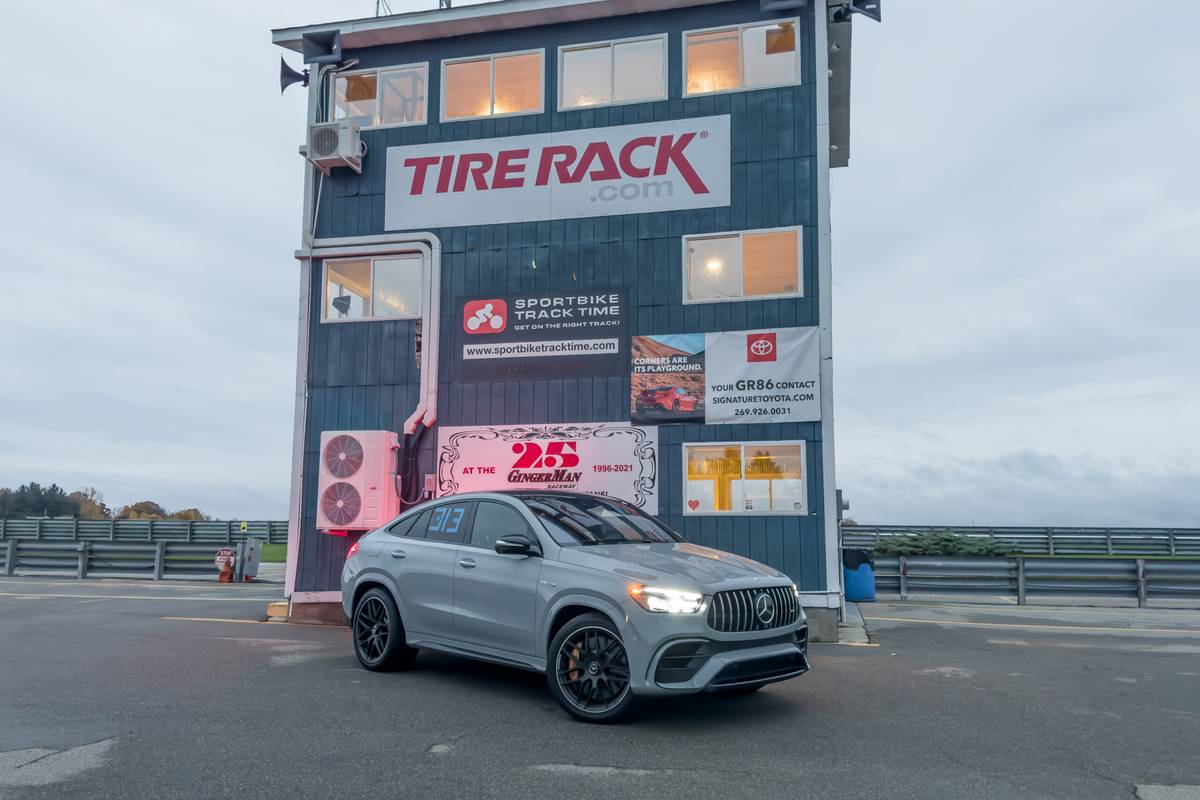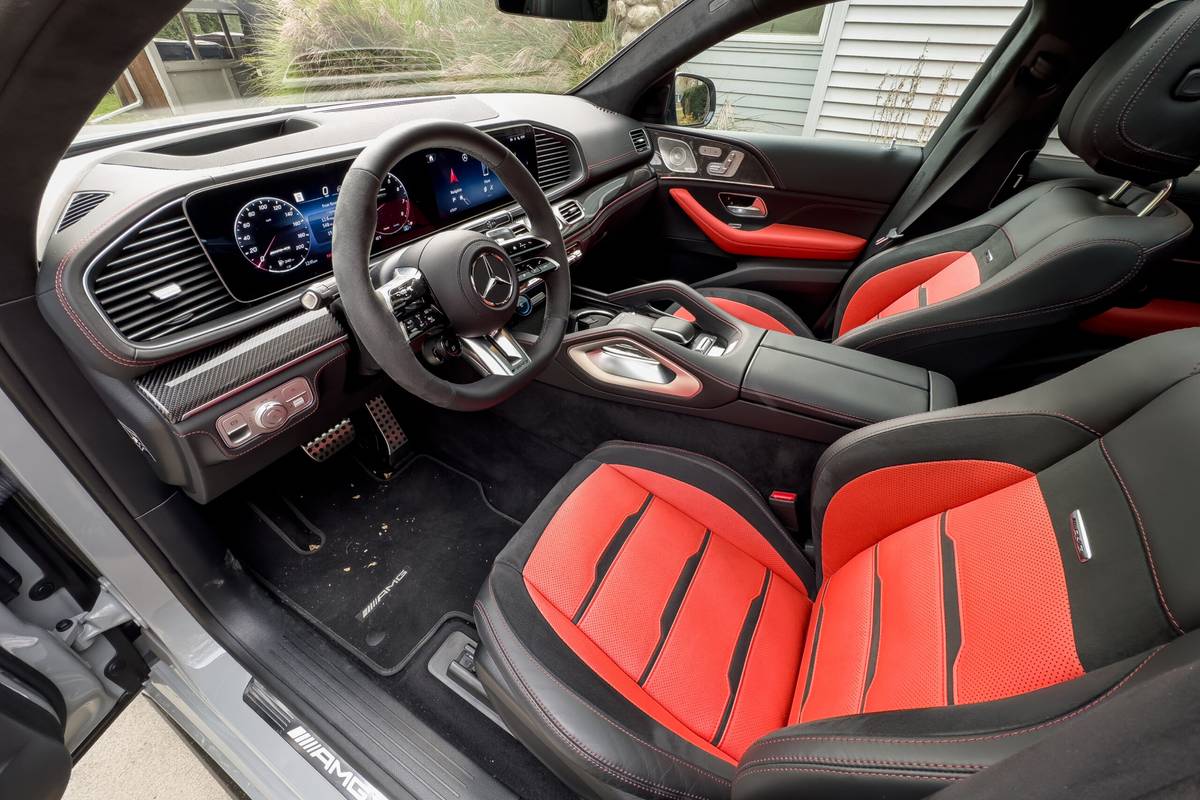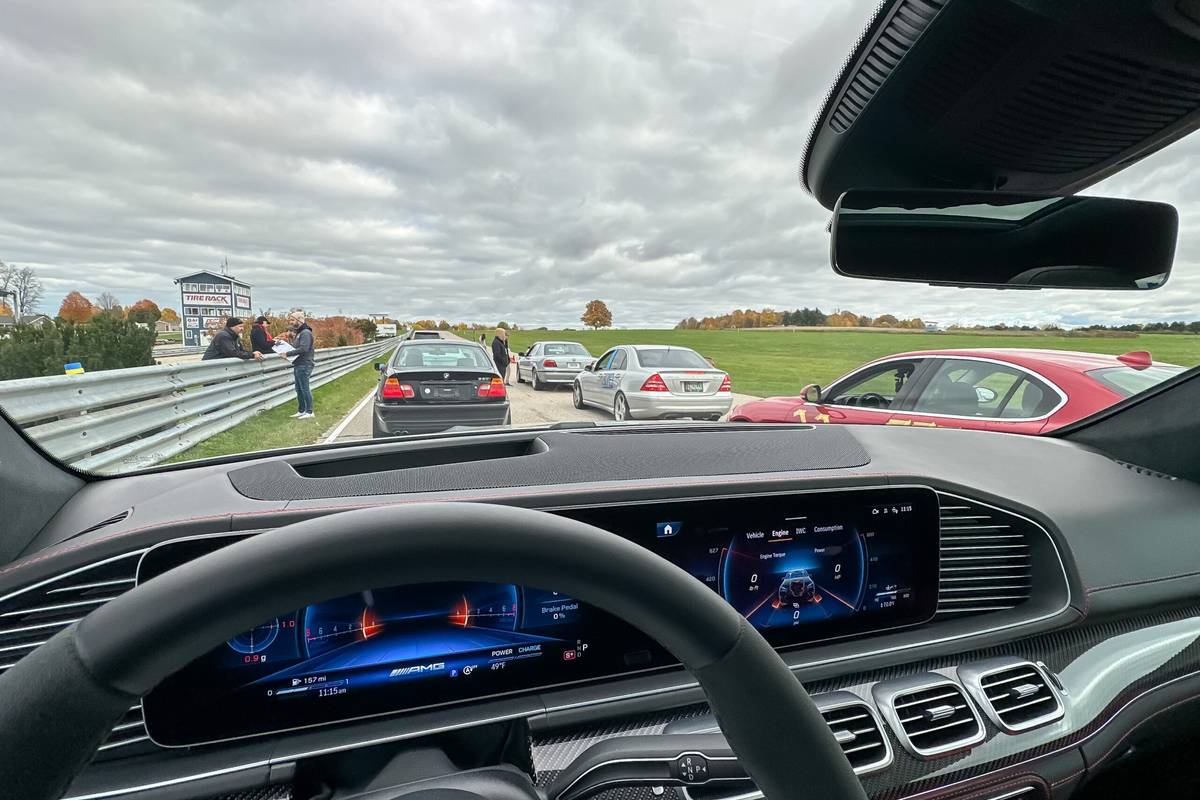2024 Mercedes-AMG GLE63 S Coupe: Will It Track? Should It Track?


I have on several occasions in reviews, YouTube videos and discussions (both online and in person) declared the idea of sporty SUVs to be ridiculous. A tall-riding, five-plus-person, four-wheel-drive family machine does not lend itself to being stuffed full of powerful engine and sport suspension to try and make it an engaging, enjoyable track machine. I’ve always maintained that an SUV is the thing you drive to the track and a sports car is what you drive on the track, perhaps towed there by said SUV. Why does a theoretical “sports SUV” (which is something of a redundant phrase, like “PIN number” or “ATM machine”) not make sense? Physics works against it — a sports car, whether it’s a two-door coupe or a four-door sedan, is lower and lighter than an SUV, two things you want in a track vehicle.
Why then, are German luxury automakers so intent on trying to sell us on the idea of sports SUVs? BMW’s M and Mercedes-Benz’s AMG performance divisions have both developed crazy-powerful, loaded SUVs, and it has to be for more than just being able to charge more money for more power to affluent Californians willing to pay for the badge. They all have track-related drive modes, massive performance tires, electronic suspensions, and tons of software dedicated to displaying gauges and meters related to high-performance driving conditions that you’d never need for even the twistiest canyon road. Simply put, the Germans have put a lot of effort into making high-performance, super-expensive SUVs that ostensibly should be track-capable.
As someone who likes track driving in sports cars and laments the decreasing number of new ones available to buy, and with a track event I’d signed up for (without a suitable vehicle) rapidly approaching, I decided to find out if one of these big performance monster SUVs is a worthy replacement for a sports sedan.

Das Monster Kommt
What arrived at my door was this: a 2024 Mercedes-AMG GLE63 S Coupe. Let’s decipher that long moniker: It’s an AMG (tuned by Mercedes’ performance division) GLE (Mercedes’ mid-size AWD luxury SUV) 63 (featuring a twin-turbo 4.0-liter V-8 engine) S Coupe (this is the low-roof hatchback version). There’s a GLE63 S SUV, as well, which has a traditional SUV profile, but the coupe SUV trend refuses to die, so we’re driving something with less useful cargo space and headroom than a normal SUV and being charged more for it. The total as-tested price of this matte-silver beast was $147,260 (prices include destination), but for 2024, it comes with more standard equipment than previous models: things like massaging front seats, a head-up display and an in-cabin fragrance system.
Despite the fact that it’s a massive, hulking five-seat SUV that’s designed to look like a sports sedan, it does come equipped with things that should make it work better on a track. That hand-built engine is the big thing — a twin-turbocharged 4.0-liter V-8 engine making 603 horsepower and 627 pounds-feet of torque are becoming rare in our increasingly electrified world, so I’ll celebrate this one mightily. It’s mated to a sport-tuned nine-speed automatic transmission sending power to all four wheels. The suspension is an electronically controlled air suspension, and the coupe has 22-inch wheels fitted with massive sticky Yokohama rubber to get power to the pavement. My model also featured the optional carbon-ceramic braking system, a $5,450 option, and of course there are all manner of adjustable settings and modes to play with in the GLE63 S Coupe that let you tailor things like throttle response, steering feel, transmission shifts and suspension firmness to the conditions you find yourself in.

Boulevard cruising is by far the most likely place you’ll find one of these, like Rodeo Drive in Beverly Hills. But AMG has gone through a lot of trouble and expense to supposedly make this thing ready for track duty, and Mercedes-Benz knew what I intended to do with the vehicle and still sent it to me anyway. So, after gassing it up and throwing my helmet on the passenger seat, I headed out in the posh, comfortable GLE S Coupe to my date with a racetrack.
The Event
The track event in question was the Rainbow Road Trackcross organized by my friends at Out Motorsports, a late-in-the-season gathering held at the excellent GingerMan Raceway in South Haven, Mich. A trackcross is an autocross-style event held on an actual racetrack instead of in a big parking lot, meaning it’s not wheel-to-wheel track racing but a single timed lap done in several heats. The benefits of such an event are that you’re still driving full tilt on an actual racetrack, and given it’s not wheel-to-wheel racing, insurance is presumably easier to come by for the organizers. It’s also a hell of a lot more fun and engaging than an autocross, as speeds reach much higher levels than you’d ever get at the local community college asphalt commuter lot, and you need to know some track driving skills like proper braking, apexing turns, where to focus your attention, things like that. It boils down to a track day where you get one lap at a time, but potentially a dozen laps or more over the course of multiple heats and two days on one of the region’s top racetracks. All skill levels and types of vehicles are welcome, from $2,000 beaters bought specifically for the event to six-figure supercars like my borrowed Merc. Vehicles are separated into groups based more on driver skill and comfort than vehicular ability or price since you’re competing against other drivers’ times rather than engaging in wheel-to-wheel racing.

The event was held the last weekend in October 2023, which any Michigan local can tell you is a risky proposition — weather in western Michigan that time of year is wildly unpredictable and can range from sunny and mild to buried in lake-effect snow. We lucked out with windy, cool, mostly dry conditions (which changed to 5 inches of snow just two days after the event). My competitors’ vehicles ranged from a brand-new Mitsubishi Mirage with all of 78 hp to a terrifying, probably-should-be-scrapped-for-parts 1996 Lincoln Mark VIII coupe missing most of its window glass. But the ones I kept an eye on were a BMW M3, Cadillac CT4 Blackwing, two Mitsubishi Lancer Evolutions, a Porsche Boxster and a Lexus GS F — things that in the hands of skilled drivers should’ve easily provided excellent competition for my Teutonic titan given their significant mass (if not power) advantages.
How It Did
Everyone got a few warmup laps to learn (or relearn) the track before every session, put a little heat in the tires (and in my case, the carbon-ceramic brakes) and get comfortable with the conditions. As I sat there in the rumbling GLE, I began flipping the proper settings on, contemplating whether Sport+ or Race modes would be best for what I was about to do. With tire pressures properly set and my helmet tightly affixed, I ran my runs in the beast with increasing confidence as the day wore on, developing some significant impressions of the GLE63 S Coupe as I flung it around the course.
The first and most overwhelming impression is that you cannot hide the vehicle’s sheer mass, regardless of how much electronic assistance is at work. The thing weighs more than 5,600 pounds, which is not what anyone would consider a characteristic of anything sporty. Lightweighting wasn’t in the mission profile for AMG engineers here despite what the proliferation of decorative carbon-fiber bits throughout the cabin might suggest; instead, AMG engineers compensated for the GLE63 S Coupe’s bulk with power — lots of it.

The second impression you have, right after “Wow, this thing is porky,” is “Holy crap, this thing is fast” — not just quick, mind you, though it is that too (Mercedes says it can run from 0-60 mph in just 3.7 seconds), but genuinely fast. The top speed is limited to 174 mph, and while I didn’t approach that level of speed, I did routinely enter well into the triple digits on long straight parts of GingerMan Raceway. A stab of the accelerator is accompanied by an absolutely glorious roar from the quad pipes, made louder by the selectable nature of the exhaust system. Bystanders reported that every time the big Benz roared past or took off from the start line, all heads would turn its way.
It was during this event that I finally found the religion that is carbon-ceramic brakes. Every other experience I’ve had with this kind of braking system has been on the street where such a system is generally terrible, but I’ll admit this latest version on the GLE63 is inoffensive in everyday driving. It’s not squeaky or loud, doesn’t behave oddly when used casually, and you might not even realize it is a high-performance braking system while fetching groceries. But on the track, it’s nothing short of revelatory. You have to get the brakes nice and warm in order for them to work well, which is antithetical to conventional brakes that get softer and tend to fade in their effectiveness as more heat gets into the rotors, pads and fluid. But the system just kept allowing me to maintain speed much farther into corners than I otherwise would have been able to with conventional brakes, stomping on them with as much force as my leg could muster and trusting them to still provide predictable, powerful stopping force time and again, corner after corner. Being able to shed speed quickly is just as important to going fast around a track as being able to accelerate quickly, and the GLE63’s optional carbon-ceramics are worth every penny in that regard. They never once wavered, smelled odd, got mushy or did anything to undermine my confidence in them.
My overall impression, however, is this: Yes, the Mercedes-AMG GLE63 S Coupe can indeed provide a fun and entertaining experience on a track. Its chassis balance is remarkably good, enabling you to transfer weight around in corners using mostly gas-pedal inputs. The electronic limited-slip rear differential also comes into play often — the GLE rarely loses composure or traction, even when being driven quite aggressively. Feedback through the steering wheel is acceptable but doesn’t really improve with sportier settings; steering effort just gets heavier, improving the overall feeling. As one of likely only a handful of people aside from Mercedes engineers ever to drive this beast on a track, I can report that it can indeed do it.
It was even much more successful in the weekend competition than I had expected, routinely finishing second or third overall in heat after heat versus 28 other vehicles, all of which were smaller and lighter than the GLE63. While I’d love to credit that result to my amazing driving skills, the more realistic explanation is a simpler one: As the old saying goes, there’s no replacement for displacement. While the 4.0-liter V-8 wasn’t the biggest in the contest, it was by far the most powerful.
What couldn’t it beat? A Toyota chassis development engineer driving his (significantly lighter) personal Lexus GS F sedan was consistently a few seconds quicker around the course than the big Mercedes, but the GLE gave up nothing to anyone else. I credit that to the immense well of power from the insane twin-turbo V-8 engine and vein-popping stopping force of the carbon-ceramic brakes.
More From Cars.com:

You Can Track It, But Should You?
So yes, you can take a big five-seat SUV to a track and have a good time with it. Will any owner of this beast actually do so? I highly doubt it. People who can afford $150,000 luxury SUVs aren’t buying them to race them; this most likely is a vehicle purchased to be seen in, and the vast majority of its parts and systems meant to help it fly around a racetrack will never even be activated.
But should owners take these beasts to a track? If you’ve never had the opportunity to drive a light, powerful, low-slung sports car around a racetrack, then sure, there’s no reason you can’t bring your big, heavy, five-seat Mercedes-AMG SUV to the track and still have a good time. But you’ll have a better time in something smaller, lighter, cheaper and much more suitable to the task at hand. The AMG GLE63 S Coupe is indeed a legitimately track-capable vehicle, but it’s not something most folks would (or should) choose for this kind of driving. Frankly, I think it’d make a better out-on-the-street getaway vehicle should you misguidedly decide to rob a bank. I still maintain this is the vehicle you should use to tow your racecar to the track — it’s rated to tow up to 7,700 pounds when properly equipped — but just know that when you get there, if the racecar won’t start, the 2024 Mercedes-AMG GLE63 S Coupe can easily stand in for it.
Related Video:
Cars.com’s Editorial department is your source for automotive news and reviews. In line with Cars.com’s long-standing ethics policy, editors and reviewers don’t accept gifts or free trips from automakers. The Editorial department is independent of Cars.com’s advertising, sales and sponsored content departments.

Detroit Bureau Chief Aaron Bragman has had over 25 years of experience in the auto industry as a journalist, analyst, purchasing agent and program manager. Bragman grew up around his father’s classic Triumph sports cars (which were all sold and gone when he turned 16, much to his frustration) and comes from a Detroit family where cars put food on tables as much as smiles on faces. Today, he’s a member of the Automotive Press Association and the Midwest Automotive Media Association. His pronouns are he/him, but his adjectives are fat/sassy.
Featured stories




